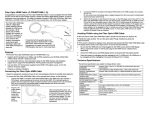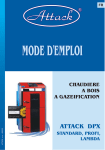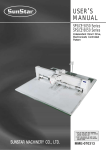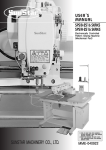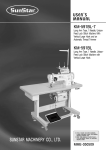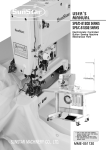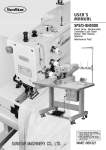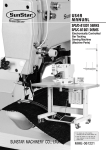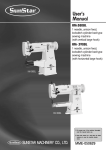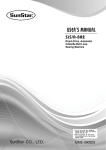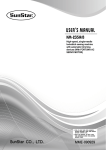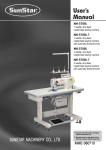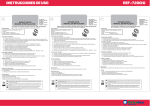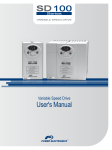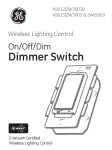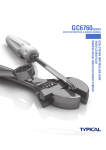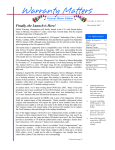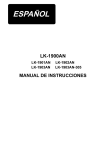Download SPS/S-CV1
Transcript
R SPS/S-CV1 Automatic Cap Visor Sewing Machine 썬스타산업봉제기계주식회사 1) FOR AT MOST USE WITH EASINESS, PLEASE CERTAINLY READ THIS MANUAL BEFORE STARTING USE. 2) KEEP THIS MANUAL IN SAFE PLACE FOR REFERENCE WHEN THE MACHINE BREAKS DOWN. MME-060105 lity a u tQ Besst Pricevice Be st Ser Be 1. Thank you for purchasing our product. Based on the rich expertise and experience accumulated in industrial sewing machine production, SUNSTAR will manufacture industrial sewing machines, which deliver more diverse functions, high performance, powerful operation, enhanced durability, and more sophisticated design to meet a number of user’s needs. 2. Please read this user’s manual thoroughly before using the machine. Make sure to properly use the machine to enjoy its full performance. 3. The specifications of the machine are subject to change, aimed to enhance product performance, without prior notice. 4. This product is designed, manufactured, and sold as an industrial sewing machine. It should not be used for other than industrial purpose. R SUNSTAR MACHINERY CO., LTD. Contents 1. Machine Classification and Specification ------------------------------------------------------ 4 1.1 Classification-------------------------------------------------------------------------------------- 4 1.2 Specification ------------------------------------------------------------------------------------- 4 2. Safety Rules-------------------------------------------------------------------------------------------- 5 2.1 Safety Indication --------------------------------------------------------------------------------- 5 2.2 Delivery-------------------------------------------------------------------------------------------- 6 2.3 Installation----------------------------------------------------------------------------------------- 7 2.4 Operation ------------------------------------------------------------------------------------------ 7 2.5 Repair ---------------------------------------------------------------------------------------------- 8 2.6 Safety Label Type-------------------------------------------------------------------------------- 8 2.7 Label Attachment Location--------------------------------------------------------------------- 9 3. Basic Assembly-------------------------------------------------------------------------------------- 10 3.1 Name of Each Part ----------------------------------------------------------------------------- 10 3.2 Sewing Machine Installation------------------------------------------------------------------ 12 3.3 Peripheral Device Installation ---------------------------------------------------------------- 13 4. Machine Operation --------------------------------------------------------------------------------- 15 4.1 Electric Power Setting ------------------------------------------------------------------------- 15 4.2 Oil Supply --------------------------------------------------------------------------------------- 16 4.3 Needle -------------------------------------------------------------------------------------------- 16 4.4 Thread -------------------------------------------------------------------------------------------- 17 4.5 Transfer Device --------------------------------------------------------------------------------- 20 4.6 Trimming Device------------------------------------------------------------------------------- 27 4.7 Motor Installation and Adjustment ---------------------------------------------------------- 29 4.8 Clamp Adjustment ----------------------------------------------------------------------------- 30 4.9 Clamp Operation ------------------------------------------------------------------------------- 30 4.10 Pattern Image Insertion----------------------------------------------------------------------- 31 5. Maintenance & Repair----------------------------------------------------------------------------- 32 5.1 Regular Checkup ------------------------------------------------------------------------------- 32 5.2 Lubrication -------------------------------------------------------------------------------------- 32 5.3 Cleaning------------------------------------------------------------------------------------------ 34 6. Pneumatic Circuit Diagram ---------------------------------------------------------------------- 35 7. Trouble Shooting ------------------------------------------------------------------------------------ 36 3 1 Machine classification and specification 1.1) Classification SPS / S- CV 1 Standard Special Cap Visor 1.2) Specification Category SPS/S-CV1 Needlework scope (X,Y) 300mm X 180mm Sewing speed Maximum of 1,500spm Stitch length 0.1~12.7mm Needle MR5 DP17, MR4 DP17 Hook Large rotary hook Presser foot lift amount Maximum of 20mm Presser foot stroke 4mm(0~7mm) Trimming device Basic supply Emergency switch Basic supply Memory device 3.5 FDD(2HD) Possible input pattern number Maximum of 691 pattern Possible input needle number Maximum of 360,000 needle Reduction/expansion ratio 1~400%(0.1% STEP) SPS/B Series : 500W direct drive AC servo motor Main drive motor SPS/B Series : 500W AC Servo Motor 4 Transfer system Transfer by stepping pulse motor Power Simple-phase 110V ~ 240V, triple-phase 200V ~ 440V, 50/60Hz Air pressure 0.49Mpa 2 Safety rules 2.1) Safety indication Safety Rules define caution , danger , warning in this manual and indicate that failure to obey the rules may bring damages, personal and physical, or machine breakdown. No. Name Caution Contents Danger of personal or physical damages from mishandling CAUTION Warning Danger of death or serious injury from mishandling Danger Danger of death or serious injury and other high level of serious condition from mishandling WARNING DANGER 5 2.2) Delivery Danger indication Explanation Machine should be carried by those who know safety instruction and rule well and the following rules should be obeyed. 2.2.1) by Human Delivery Wear hard safety boots and hold machine tightly on both sides. DANGER 2.2.2) by Fork-Lift Truck 1) Truck should be strong and large enough to hold machine weight and carry it. 2) Use palette and adjust fork-arm to the center of machine (the center of left and right sides), and then lift it carefully Prevent people from passing by and remove obstacles under machine. WARNING 6 Keep machine horizontal to prevent its deformation people’s exposure to danger in case of using delivery equipments such as fork-lift truck or crane. 2.3) Machine installation CAUTION 2.4) Machine Operation WARNING Wrong machine Installation may cause malfunction & breakdown and other physical damages so comply with what follows. 1) Workbench or table should be strong enough to hold machine weight (see face plate) 2) Implement regular check-up with Air Conditioner as dust and humidity cause contamination and corrosion. 3) Keep machine out of direct sunlight. (Long exposure to direct sunlight is a source of color change and deformation.) 4) Leave at least over 50cm space to left and right sides of machine to allow enough repair space. 5) Explosion accident : To avoid explosion, stop operation when there is combustive material in the air. 6) Work light: Lighting doesn’t come with machine so that lighting should be separately installed for machine operation. 7) Subversion danger : Don’t place machine at an unstable stand or table which will give serious shock to people and machine if it falls down. Sudden stop while moving machine or exterior shock may cause subversion. SPS/S-CV1 is manufactured to sew textile and its similar texture. Machine body has caution and warning stickers at each danger part to call attention to safety indication, which should be kept in mind and obey what follows in operating machine. 1) Read this manual and fully understand how to operate it before use. 2) Have safety outfit on. A long hair, a necklace, a bracelet or a wide sleeve may get jammed into machine. Slip-proof shoes are also necessary. 3) Check operation scope in order for machine not to encounter obstacles in operation 4) Keep a hand or a head away from accident-vulnerable parts (needle, hook, thread lever, pulley). 5) Don’t remove safety cover protecting pulley or shaft for a user’s safety while operating. 6) When dismantle electric box including control box, make sure electricity is blocked and power switch is “off”. 7) When rotate upper shaft with hands, make sure power switch is “off”. 8) Ensure that machine stops when thread a needle or until after-work check. 9) Failure to obey what follows will bring physical damages including malfunction & breakdown. Comply with the following instruction. - Don’t place things on machine table. - Don’t use bent or end-damaged needle. - Use palette suitable for work condition. 7 When repair is needed, it should be made by a designated A/S technician only who is trained in our company. 2.5) Repair 1) In order to maintain machine such as cleaning and repair, make sure to block main power and wait for four minutes during which electricity is completely discharged. DANGER CAUTION Wait for ten minutes for main shaft motor and X/Y drive box to be completely discharged after main power is blocked. 2) Don’t change specification or parts without consultation with our company otherwise safety is threatened during operation. 3) Use SWF pure authentic parts for repair and parts replacement. 4) After repair, reinstall all the safety covers that were detached during repair. 2.6) Safety Label Type CAUTION 경 고 Do not operate without finger guard and safety devices. Before threading, changing bobbin and needle, cleaning etc. switch off main switch. 손가락 보호대와 안전장치 없이 작동하지 마십시오. 실, 보빈, 바늘교환시나 청소전에는 반드시 주전원의 스위치를 꺼 주십시오. WARNING Injury may be caused by winding. Be sure to turn off the power before cleaning, lubricating, adjusting or repairing. 8 Do not operate without finger guard and safety devices. Before threading, changing bobbin and needle, cleaning etc. switch off main switch. Injury may be caused by winding. Be sure to turn off the power before cleaning, lubricating, adjusting or repairing. 2.6) Label Attachment Location WARNING Injury may be caused by winding. Be sure to turn off the power before cleaning, lubricating, adjusting or repairing. CAUTION 경 고 Do not operate without finger guard and safety devices. Before threading, changing bobbin and needle, cleaning etc. switch off main switch. 손가락 보호대와 안전장치 없이 작동하지 마십시오. 실, 보빈, 바늘교환시나 청소전에는 반드시 주전원의 스위치를 꺼 주십시오. 9 3 Basic Assembly 3.1) Name of each part 3.1.1) Each part ③ ⑪ ⑤ ② ⑩ ⑨ ⑧ ① ⑫ ④ ⑦ ⑥ 10 1 Power ON/OFF 7 Clamp pedal 2 Arm 8 Clamp button 3 Table 9 Sewing start button 4 Control box 10 Emergency stop switch 5 Operation box 11 Thread stand 6 Sewing start pedal 12 Clamp 3.1.2) Inside of control box fan Floppy disk drive Step motor drive board Power board Main shaft motor drive board Transformer IO board 386 CPU board 11 3.2) Sewing machine installation 3.2.1) Installation condition 1) Don’t use if it accounts for more than 10% of rating voltage to prevent wrong operation-induced accident. 2) Check designated pressure for devices using air pressure including A-cylinder to prevent wrong operation-induced accident. CAUTION Comply with installation condition of this manual for the best operation. Otherwise there will be unexpected breakdown. 3) For operation : 0° 40°C (32° 104°F) 4) For maintenance : -25° 55°C (-13° 131°F) 5) Humidity - relative humidity : within 45 85% 3.2.2) Electricity Installation Condition Power voltage should be within 10% fluctuation of rating voltage WARNING 1) Power voltage - Voltage should be within 10% fluctuation of rating voltage - Frequency should be within 1% of rating frequency(50/60Hz). 2) Electromagnetic waves noise - Separate electric power with strong magnetic and high wave products and never keep both of them close. 3) Don’t make water and coffee enter into control box and motor. 4) Don’t drop control box and motor. 3.2.3) Table stand installation 1) Table fixing - Insert shock-absolving rubber into level adjuster and raise it until caster moves freely. - After installation, fix level adjuster by tightening nut. 2) Table height adjustment - Adjust height by loosening bolt slightly attached to table and tight it again completely. Bolt Nut Level adjuster Shock-absolving rubber Caster 12 3.3) Peripheral Device Installation 3.3.1) Operation box stand assembly - Combine operation box stand with a table and then fix it with bolt. 3.3.2) Motor cover - Attach motor cover with a turnbuckle. Turnbuckle Motor cover 3.3.3) Standing pedal installation - Connect standing pedal plug to control box. Standing pedal 13 3.3.4) Thread stand installation - Install thread stand on a table. While attaching using tools, be careful not to drop one of the parts and get injured. CAUTION 3.3.5) Installation of pneumatic controlling parts 1) Filter regulator Install a filter regulator at the bottom of a table support with a bolt. When connecting an air hose, use a quick joint socket to link it to the quick joint plug attached on a regulator. 2) Solenoid valve Fix a solenoid valve to a table support with a set bolt. Finger valve Hose Plug Quick joint socket CAUTION 14 1) Adjust proper pneumatic pressure to 5~5.5kgf/cm (0.49~0.54MPa). 2) When the pressure drops less than 4kdf/cm, machine stops operating with an error message. (Error message: Err 24 (Low Pressure!) 3) When you turn off the finger valve after use, residual air is automatically emitted and remaining pressure indicates 0Mpa (0kgf.cm). 4 Machine Operation 4.1) Voltage set-up 1) Detach a cover of electric controlling pattern sewing machine to check whether components are the same with those in the picture below. 2) Check whether location of power voltage switching connector in electric board and transformer use are chosen properly to match with input voltage shown in table1 and table 2 shows. Ex) If power voltage is 220V, the transformer model should be “SPS-□□□□-220”and the location of power voltage switching connector,“JP5”. The transformer model can be found in a sticker attached on the upper part. Power voltage 95V ~ 105V Location of power voltage switching connector JP4 106V ~ 115V JP3 116V ~ 125V JP2 200V ~ 230V JP5 231V ~ 245V JP4 345V ~ 415V JP3 416V ~ 480V JP2 Input voltage [Table1. Location of voltage switching connector] Machine model SPS /S -CV1 100V ~ 120V SPS-1306-110(for common use) 220V ~ 440V SPS-1306-110(for common use) 3) Check whether power switch is for a single-phase or for a triple-phase. 4) If 2) and 3) are not available, it may be in danger of breakdown. Thus, take the following measures to avoid machine damage. Ex) In case the location of power voltage switching connector is not appropriate, - Separate transformer connector CN7, CN8, and CN9 from power board. - Switch power voltage switching connector to the proper location of table1. - Reconnect transformer connector CN7, CN8, and CN9 to power board. If transformer and power switch do not conform to specification, exchange or repair in the store you purchase them. CAUTION 15 4.2) How to supply oil 4.2.1) oil supply location In the first driving of a sewing machine, check the amount of remaining oil through the window of each oil supply place, and complement the insufficient part. 4.3) Needle 4.3.1) Needle attachment Loosen a needle turnbuckle of a needle bar and push the needle until its upper tip reaches the end of needle insertion mouth of the bar with the needle long hole facing forward. And then, fix the needle by using a needle fixing screw. Needle turnbuckle Needle 4.3.2) Adjusting needle bar height Loosen turnbuckle holding a needle bar holder at the lowest point of the bar to make the upper line matching with specification conform to the lower face of a needle bar bushing. Then, screw the bar turnbuckle. Turnbuckle DPX17 Less than #22 16 DPX15 DPX17 More than #22 4.3.3) Adjusting needle and hook When a needle bar rises at the lowest point of a needle bar, align the lower line which fits the applied needle to the lower face of a needle bar bushing. Needle bar lower bushing DPX5 DPX17 Less than #22 DPX17 More than #22 4.3.4) Threading a needle Thread a needle after moving a thread take up lever to the highest point, when holding a thread like ① for thick materials, and like ② for knitwear, general and thin materials. ① For thick materials ② For general materials 4.4) Thread 4.4.1) Holding Upper and lower thread 1) Hooking upper thread Place the thread take up lever on the highest position, and hold the thread by making it pass through major and minor thread tension control ass’y as the same with the picture. 17 2) Hooking lower thread Put bobbin into bobbin case. Then, pass a thread through a thread hole, and hook the thread under a tension adjusting plate spring. 4.4.2) How to separate bobbin case Grab the handle of bobbin case, and push it into a hook until a sound is heard. Operating machine while the bobbin case does not enter fully can lead to tangled thread or make bobbin case spring out. CAUTION 4.4.3) How to adjust tension 1) Adjusting upper thread tension Turn the tension nut of major and minor thread tension control ass’y clockwise to strengthen the tension of an upper thread; turn them counterclockwise to weaken the tension. To control thread tension, adjust the tension depending on the sewing conditions such as sewing materials, threads, and stitch numbers. Strong Minor thread tension control ass’y Weak Strong Major thread tension control ass’y Weak 18 2) Adjusting thread take up lever spring tension Adjust major thread tension control ass’y shaft by turning a bolt with a driver. Turn the bolt clockwise to strengthen the tension of a thread take up lever spring; turn it counterclockwise to weaken the tension. (Standard moving length: 6~8mm, tension: 30~50g) Strong Weak Thread take up lever spring 3) Adjusting lower thread tension Turn tension adjusting screw of bobbin case clockwise to strengthen the tension of lower thread; turn it counterclockwise to weaken the tension. Strong Weak Tension adjusting screw 4.4.4) How to wind lower thread 1) Insert bobbin to bobbin winder drive shaft of bobbin winder base attached to a top cover. 2) Attach bobbin winder lever on bobbin, and press pedal to operate machine. 3) After bobbin winder lever falls from bobbin, use a bobbin winder knife to cut the thread. 19 4.4.5) Adjusting bobbin winder amount Bobbin Use the initial position of a bobbin winder adjusting plate. If bobbin winder amount is large, loosen a turnbuckle of adjusting plate to turn it into A direction and if the amount is small, turn it into B direction. A B Bobbin winder adjusting plate 4.4.6) Adjusting location of bobbin winder drive wheel Upper shaft 1mm Adjust the location of bobbin winder drive wheel to have a 1mm distance from presser foot drive cam. Then, screw a turnbuckle. Presser foot drive cam 4.5) Transfer device 4.5.1) Adjusting height of presser foot 1) Loosen the turnbuckle of presser foot at the lowest point of a needle bar. 2) Adjust presser foot height depending on thickness of sewing materials, and tighten the turnbuckle. 20 Turnbuckle Bobbin winder drive wheel 4.5.2) Adjusting presser foot device 1) Align the end of presser foot cam with the center of upper shaft carved mark, and the carved line of the cam with the carved mark. And then tighten a turnbuckle. ① Carved mark Upper shaft When presser foot drive cam is not properly placed, its vertical movement timing of the foot is not right, which may cause friction between the needle plate and the foot. CAUTION 17mm 2) Adjusting presser bar height Adjust presser bar end to 17mm in the bar holder. And then tighten a turnbuckle after checking a needle passes through the center of the presser foot. Presser bar Presser bar holder Presser foot Tighten presser bar turnbuckle with 40~45kgf/cm pressure. Excessive pressure may cause deformation of the bar and problem in operation. WARNING 3) Adjusting presser foot adjusting arm Make a space between location link stopper and fixing link hinge screw of presser foot movement by loosening location link stopper screw. Loosen fork link screw and place the foot link hinge screw to the right side of the foot adjusting arm. And then tighten the link hinge screw. Place needle bar at the lowest point by turning a hand pulley. Raise presser bar and tighten the fork link turnbuckle to set the distance to allow 4mm between the bar holder and the bar bushing Adhere the location link stopper closely to the foot moving link hinge screw by tuning the stopper turnbuckle. Tighten fork link screw and check to make sure that there is no extra space in vertical movement of the foot adjusting arm. Adjust the foot stroke after checking the tightening condition of screws. 21 CAUTION 1) Insufficient space between presser bar holder and presser bar bushing may interrupt operation and make a noise. 2) Failure to tighten screw completely after adjusting can bring damage to the machine during operation. 3) If the foot moving link hinge screw does not adhere to the end of location link stopper closely, a noise can become louder because the machine trembles during operation. Presser adjusting arm Turnbuckle Stopper Hinge screw 4mm Presser bar holder Presser bar bushing 4) Adjusting presser foot stroke (upper, lower movement adjustment) After loosening the foot hinge screw, move presser foot adjusting arm to A direction to make the foot stroke bigger, and to the B direction to make the presser foot stroke smaller. (Stroke is set at 4mm in a released machine to a market.) B A Hinge screw 4.5.3) Adjusting thread release components 1) Setting thread release notch location Place the right side of long hole of thread release notch to reach the circumference of the thread release notch turnbuckle. And then fix it with a turnbuckle. Turnbuckle Notch If location is not properly set, remaining thread amount may be smaller or irregular. And also thread may fall out of needle at the beginning of sewing. CAUTION 22 2) Setting thread release stopper Remove thread release return spring. Adjust the space between thread trimmer drive link and thread release lever pin to 0.3mm after loosening the turnbuckle of thread release stopper. To make narrow the space between thread trimmer drive rink and thread release lever pin, push thread release stopper to the right, and to make the space wide, push the stopper to the left. Hook thread release return spring. Thread release lever pin Thread trimmer drive rinkThread release return spring 0.3mm Thread release stopper Turnbuckle Widening Narrowing For your safety, use tools when you attach or detach thread release return spring. WARNING 3) Adjusting opening of the thread guide disk Loosen the turnbuckle of thread release adjusting plate. Perform a trimmer function to open the thread guide disk. Adjust the opening of thread guide disk to 0.6~0.8mm for general materials and to 0.8~1mm for heavy materials. Wider angle of thread release adjusting plate makes the disk opening wide and narrower angle makes it narrow. Tighten a turnbuckle after adjustment. Widening Narrowing Opening Turnbuckle Thread release adjusting plate Thread release rink direction Thread tension control ass'y direction If the thread guide disk is not open enough, remaining thread amount may be smaller or irregular. And thread guide disk may not be completely closed. CAUTION 23 4.5.4) Adjusting hand pulley device Upper shaft 1) Put hand pulley gear in line with the end of hand pulley axis, and tighten them with a turnbuckle. 2) Align the extra space of gears connected to upper shaft and hand pulley axis, and then tighten them with a turnbuckle. 3) Adjust bushing by moving it to the right and to the left in order to minimize entangle generated between gears when a roller rides the end of hand pulley bushing. Hand pulley bushing Hand pulley axis Roller 4.5.5) Adjusting drive belt tension WARNING 1) Adjusting drive belt tension affects sewing quality and machine operation so ask the service to those who are trained in our company or equivalently qualified technicians in our company. 2) Make sure to turn “off” the machine during tension adjustment of each drive belt. 1) Adjusting X-axis tension (1) Timing belt of motor drive part Check tension of X-motor drive part timing belt with a sound wave belt tensiometer after separating X-axis rail cover from the main body. Adjust X-motor drive timing belt tension to 13~14kgf when you flip the belt center with a finger or a similar tool. Data input of sound wave belt tensiometer of a Xmotor drive part timing belt Weight : 40 gf/m Wide : 20mm/#R Span : 67 X- motor Nut Tension adjustment bolt Minor drive pulley Drive pulley Timing belt To adjust tension of X-motor drive timing belt, loosen the nut tightened to tension adjustment bolt and turn adjustment bolt clockwise for tension increase while motor-fixing bracket is pushed to the moving direction of the bolt, and turn it counterclockwise for tension decrease. (2) X–axis transfer timing belt Check tension of X – axis transfer timing belt with a sound wave belt tensiometer after moving frame attachment plate to the right completely. Adjust tension of X – axis transfer timing belt to 11~12kgf when you flip the belt of its center with a finger or a similar tool. Data input of a sound wave belt tensiometer of a X-axis transfer timing belt Weight : 3.8 gf/m Wide : 18mm/#R Span : 513mm To adjust tension of X-axis transfer timing belt, loosen the screw of tension adjustment axis and adjustment nut, and adjust the bolt to a optimum tention level. Turn adjustment bolt clockwise for tension increase and counterclockwise for tension decrease. 24 Tension adjustment axis screw Tension adjustment bolt F : 11~12kgf X frame attachment plate 2) Adjusting Y-axis tension ⓑ (1) Y-motor drive part timing belt ⓒ Check tension of Y-motor drive part timing belt F : 12~13kgf with a sound wave belt tensiometer after separating X-axis rail cover from the main body. ⓓ Adjust tension of Y-motor drive timing belt tension to 12~13kgf when you flip the belt center with a finger or a similar tool. Data input of sound wave belt tensiometer of a Yⓐ motor drive part timing belt. Weight : 4.0 gf/m Wide : 20mm/#R Span : 112mm To adjust tention of Y-motor drive timing belt, loosen fixing screws (4 places), turn tension adjustment screw to the right for tension increase and to the left for tension decrease. (2) Y-transfer timing belt Check a Y-transfer timing belt tension with a sound wave belt tensiometer after placing X-drive part to drive pulley part. Adjust tension of Y-axis timing belt tension to 30~32kgf when you flip the belt center with a finger or a similar tool. Data input of sound wave belt tensiometer of a Y-axis drive part timing belt. Weight : 3.8 gf/m Wide : 18mm/#R Span : 230mm To adjust tension of Y-axis timing belt, turn tension adjustment screw to the right for tension increase and to the left for tension decrease. X drive part Minor drive pulley F : 30~32kgf Tension adjustment bolt Tension base turnbuckle 25 4.5.6) Setting X-Y axis starting points 1) Setting up Y-axis starting point Move the center of feed plate to be in the middle toward X-axis. Loosen X-censor bracket nut to be the center of censor, and then tighten fixing screw. Sensor X sensor plate Nut 2) Setting up Y-axis starting point Move the center of feed plate to be in the middle toward Y-axis Loosen Y-censor bracket nut to be the center of censor, and then tighten fixing screw. Sensor Turnbuckle X censor plate 26 4.6) Trimming device 4.6.1) Setting thread trimming cam Adjust the distance between upper shaft collar and thread trimming cam to 2.5mm. Locate the cam carved line in the same line with the shaft carved mark, and then tighten the turnbuckle. Thread trimming cam Carved line 2.5mm Carved mark Upper shaft Upper shaft Upper shaft collar ① If the cam is in a wrong position, the trimmer may not work properly, or the machine may be stuck. CAUTION 4.6.2) Adjusting link stopper screw 1) Check whether there is enough space between the cam roller and the both sides of the cam when push the thread trimming drive link toward the cam direction at the lowest level of needle bar within the cam operating area. 2) With the roller inserted into the cam operating area, adjust the end part of the link stopper screw to reach the tightening part of the trimming connecting rod and then tighten nut. CAUTION 1) If there is no enough space between the roller and the both sides of the cam, the trimmer may not work properly, or the machine may be stuck at the beginning of sewing or during trimming. 2) If the link stopper screw is in a wrong position, the cam roller may return to its original position slowly after trimming and the screw may not be tight enough during sewing. Enough space Enough space Thread trimming drive cam roller Thread trimming drive link Thread trimming cam Connecting rod Link stopper screw Link stopper screw Nut Thread trimming connecting rod 27 4.6.3) Setting thread trimming shaft position 1) Loosen the turnbuckle of thread trimming drive link and the turnbuckle of thread trimming shaft collar. 2) Align thread trimming shaft with A part of the arm. 3) Tighten turnbuckle Thread trimming cam Thread trimming drive link Thread trimming shaft Turnbuckle 4.6.4) Setting link stopper position 1) When thread trimmer is not working, loosen the turnbuckle of thread trimming drive link. Adjust the distance between the link and the link stopper notch to 0.3mm. Turnbuckle 0.3mm Thread trimming drive link 0.3mm Thread trimming drive link stopper If position is not correct, trimmer may not work properly, or the machine may be stuck. CAUTION 4.6.5) Setting thread trimming solenoid position 1) Loosen the turnbuckle of thread trimming solenoid bracket. Adjust the distance between thread trimming shaft and the rotary link of thread trimming solenoid to 0.5mm, and tighten the turnbuckle. 2) Loosen the rotary link turnbuckle of trimming solenoid and manually drive the link to adjust thread trimming shaft to 6.8mm and tighten the turnbuckle. 3) Check to make sure that the collar is returned to its original position when the rotary link returns to its first position. Turnbuckle Thread trimming solenoid bracket Thread trimming solenoid Turnbuckle 0.5mm Rotary link of thread trimming solenoid Rotary link of thread trimming solenoid 6.8mm Thread trimming shaft If the position is not correct, the trimmer return may become slow, or the machine doesn't give the best sewing due to slow thread release. CAUTION 28 4.6.6) Adjusting moving and fixing mes 1) Adjust the distance A between thread dividing point of moving mes and needle plate hole to the same figure as given with lever adjustment screw when needle bar stops moving. B B A 4.5mm 0.5mm Fixing mes Needle plate cover A Moving mes If the position is not correct, thread can't be trimmed properly or remaining thread amount may get smaller. CAUTION 4.7) Installing and adjusting direct motor Turnbuckle #1 Servo motor 4.7.1) Attaching coupling O-Ring 1) Attaching servo motor coupling With coupling turnbuckle locating exactly at the cutting part of servo motor, adjust the distance between the coupling and the motor to 0.7mm, and tighten the coupling turnbuckle. 2) Attaching coupling to upper shaft With coupling turnbuckle locating exactly at the cutting part of upper shaft, adjust the distance closely between Bearing O-ring and the coupling to be 2mm, and tighten the turnbuckle. Upper shaft Rounding areas Upper shaft rear bearing Arm Coupling 2mm 0.7mm 4.7.2) Combining motor 1) Motor combination Combine motors carefully while making sure to align the location of motor coupling turnbuckle to that of upper shaft coupling turnbuckle. If the location of coupling turnbuckle is not correct, a needle does not stop in the right place. WARNING 29 4.8) Clamp adjustment Reducing valve 4.8.1) Pressure control of side clamp Fixing nut 1) Solenoid valve adjustment To adjust the pressure of side clamp use the pressure reducing valve of a solenoid valve attached to a table’s base. After adjusting the pressure of side clamp properly, fasten fixing nut to maintain the set pressure. 2) Pressure control Turn the reducing valve clockwise to increase side clamp pressure and counterclockwise to decrease it. 4.8.2) Adjusting forward and backward speed of middle clamp Speed controller Fixing nut 1) Adjustment of speed controller To adjust forward and backward speed of middle clamp: turn the valve of speed controller clockwise to increase speed and counterclockwise to decrease it. After completion of adjusting speed properly to operation, fasten fixing nut to maintain the set pressure. 4.9) How to operate clamp 4.9.1) Operation of clamp/start switch Start switch First, press clamp switch. The clamp moves to fix a visor to a feed plate so as not to move while sewing. And then, press start switch. The machine begins to sew on the visor fixed to clamp. Clamp switch 30 4.9.2) Operation of standing pedal Press the right side of standing pedal to operate as does clamp switch. Press the left side of the pedal to begin sewing as does start switch. Standing pedal 4.10) How to insert pattern images To insert a variety of patterns into the sewing machine by using a floppy disk. Floppy disk A floppy dist available in a market can be used after formatting. Authorized disk only. WARNING 31 5 Maintenance & repair WARNING 1) Abide by safety rules on machine and electric safety when checking, maintaining and repairing the machine. 2) These works should be one when the machine power is “OFF.” 5.1) Regular checkup 1) Regularly Clean, lubricate and pour grease into designated areas to maintain capabilities of the machine. 2) Check tension of each drive belt. 3) No regular checkup may cause the following problems: Unusual abrasion of each frictional area led by insufficient lubrication and grease pouring. Abnormal operation caused by dust and foreign substances in the drive. WARNING 1) SUNSTAR takes no responsibility for mechanical breakdown or malfunction caused by no cleaning and lubrication of the machine through regular checkup. 2) Cleaning period varies depending on using condition and surrounding environment. 5.2) Lubrication 5.2.1) Lubricant types No. Lubricant types using areas 1 Sewing machine oils Arm, bed, hook areas 2 Grease X-Y feed rail 5.2.2) How to lubricate 1) Arm Feed oil after checking the amount of remained oil in an oil tank installed in the arm. Feed oil in and upper side of an oil tank door. 2) Bed After removing a rubber cork of a table’s oil tank mouth, feed oil and then, plug up the mouth again with the cork. 32 3) Hook - Pull out a bobbin case and feed oil until it soaks in the hook and its surrounding areas. 5.2.3) Removal of residual oil Remove oil when it is full in residual oil can. 5.2.4) Grease pouring Pour grease regularly into X-Y transfer rail. 33 5.3) Cleaning 5.3.1) Frequency and method of major parts cleaning 1) Make sure to turn the machine power is “off” before cleaning. 2) Reassemble all the parts removed for cleaning in the opposite order. WARNING No. Major parts cleaning Cleaning frequency 1 Hook area Everyday 2 Thread take-up lever / Thread tension control assembly 3 Moving and fixing mes area Remove dirt at moving and fixing mes by using air under needle plate. Three times in a week 4 X-Y transfer timing pulley and timing belts Disassemble cover first and remove dirt in each part of X-Y transfer part by using air. (Rotate pulley when cleaning.) Once in a month 5 Control box and cooling fan filter Remove cover and pull off filter. Wash the filter with running water and dry completely in the shade to use. Once in a week Once in a week ① ② ③ ④ ⑤ ④ 34 6 Pneumatic circuit diagram [ SPS/S-CV1 Air System Circuit Diagram ] Side clamp AIR IN Mid clamp Presser foot A B A B EA P EB EA P EB P R A EA B P EB A 35 7 Trouble shooting 1) Machine part No. 1 2 3 4 5 6 7 36 Problems Problems of machine and operation Incorrect stop position Needle break Thread breakage Causes Solutions excessively loose belt tension or belt damage belt tension adjustment and belt change power or circuit fuse disconnection Check disconnection of major motor drive fuse in control box and change it disconnection from limited position of X or Y of feed bracket Move feed bracket to the right position (within switch limitation) loose main drive belt belt tension adjustment incorrect position of synchro synchro position adjustment needle damage (bent needle, damage on the eye of needle or hole, or worn-out or changed needle point) new needle installation incorrect needle setting correct needle installation needle and shuttle contact needle and shuttle space adjustment wrong threading correct threading wrongly inserted needle (needle height and direction etc.) needle replacement damaged needle (bent needle, damage on the eye of needle or hole, or worn-out or changed needle point) needle change too tight tension on lower and upper thread tension adjustment excessive tension and workload at thread take-up lever spring changing thread take-up lever spring tension and workload flaw on thread regulating hole area of spring on upper part spring of shuttle replacement of new spring of shuttle upper part bent needle use needle change wrong size needle for sewing thread needle change incorrect needle installationa needle reinstallation wrong needle and timing readjustment of needle and shuttle timing improper hole and wide space between hole and shuttle point readjustment of needle and shuttle timing excessive tension and workload at thread take-up lever spring adjustment of thread take-up spring tension and workload weak upper thread tension adjustment of upper thread tension weak lower thread tension adjustment of lower thread tension improper needle and shuttle timing readjustment of needle and shuttle timing loose crossed tension of moving mes and fixing mes adjustment of fixing mes tension worn-out knife edge hole of moving and fixing mes changing moving and fixing mes incorrect position of thread trimmer cam readjustment of thread trimmer cam position Skipped sewing Incorrect thread tightening Missing thread trimming




































